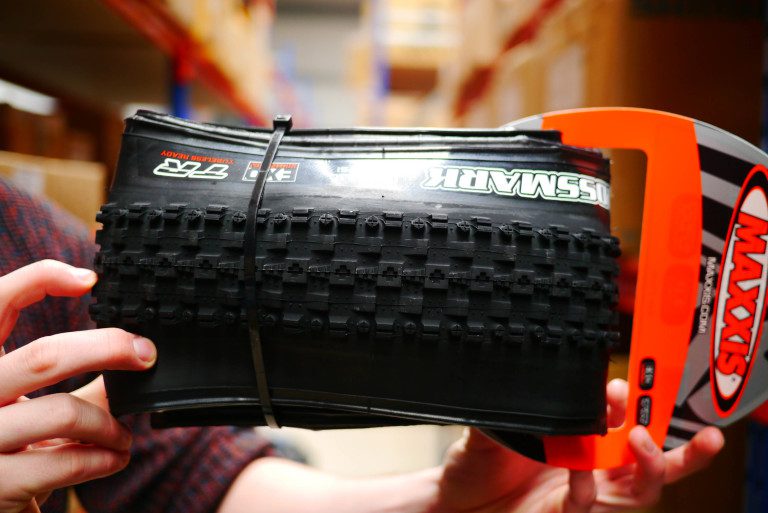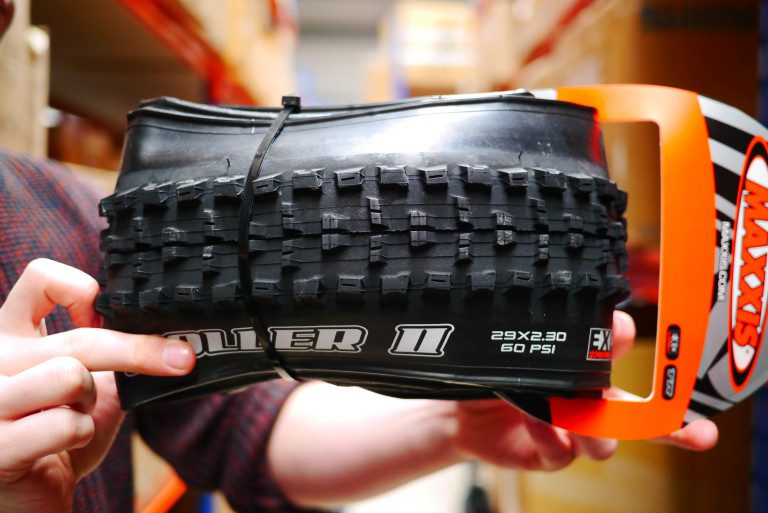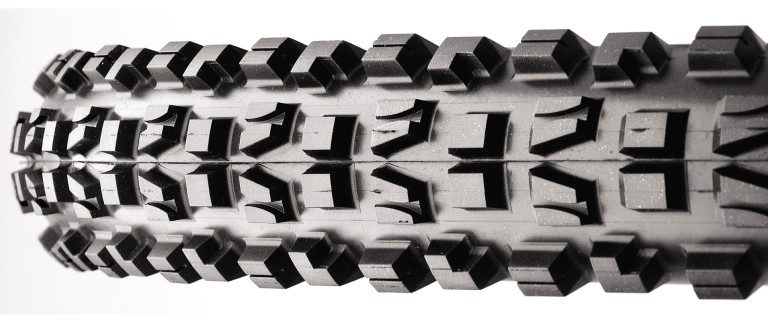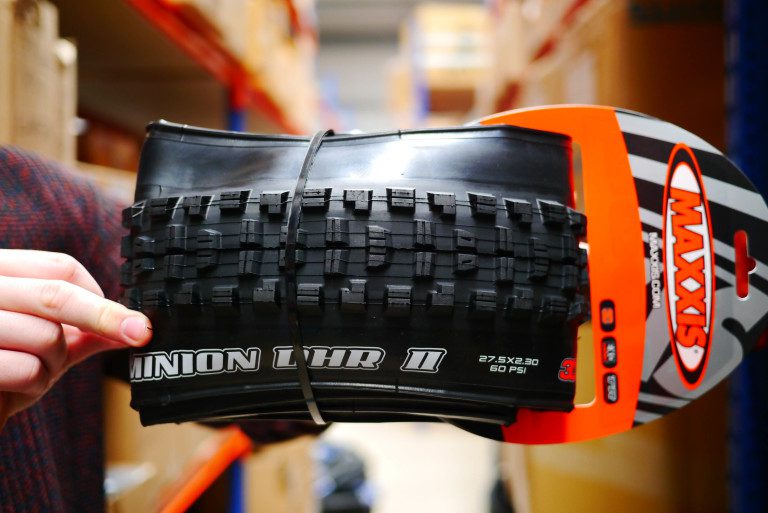Maxxis are back! And they really are better than ever. Trail tyres, enduro tyres, downhill tyres, 26″, 27.5″, 29″… There’s something for everyone.

Maxxis are actually the Cheng Shin Rubber company. They were founded in 1967 and solely produced bicycle tyres in, and for, China.
As their popularity grew, they began to produce tyres for a variety of vehicles such as cars, motorbikes and trucks. But they’re still mostly know as a bicycle tyre brand.
They are now the largest manufacturer of bicycle tyres in the world.
In the cycling industry, although they make tyres for any and every sort of bicycle, Maxxis are mostly known as a mountain bike tyre brand.
Rejigging the range
Truth be told, Maxxis’ tyre range got a bit OTT and confusing in recent years. Too many models and far too many variables of each model. It’s only in the last couple of years or so that they’ve managed to clear it up and rationalise it.
And like it or not, we have 27.5″ wheels to thank for this.
The industry’s move to the new 27.5″/650B wheel size forced all tyre manufacturers to revisit their existing designs and update or even eliminate certain designs.
This has been a good thing. Old ‘classics’ that weren’t actually very good have been killed off. ‘Nearly’ tyres have been tweaked to make them the tyres they should have been in the first place. And there’s been some brand new tyres launched to fill much-needed gaps in the market.
Enduro-a-go-go!
A great example of such a gap was the enduro market. Enduro riders/racers wanted capable tyres that didn’t weigh a ton and could be run tubeless. DH tyres were too heavy and weren’t tubeless ready. XC tyres were too flimsy and not aggressively knobbled or made of a sufficiently sticky compound.
To illustrate the new Maxxis range we’ve chosen seven tyres to talk about.

Ardent
- A large volume, fast-rolling tyre.
- A great option for speedy, contouring trails.
- Its round shoulders don’t make it ideal for steep or loose conditions.
- An extremely popular tyre in the UK.

Beaver
- A mud tyre for XC/trail use.
- Firm sub-rubber to prevent tyre squirm.
- Softer outer rubber for traction.
- Siped knobbles splay open upon contact for even more grip.

Crossmark
- Dry conditions tyre.
- Ideal for fireroad bashing.
- Also makes for an excellent fast rolling rear tyre – pair with something more aggressive up front.
- Has way more grip than you’d think.

High Roller II
- A re-jigged version of a popular All Mountain/Enduro tyre.
- A square profile tyre for technical terrain and aggressive riders.
- Best in loose or damp conditions but a good choice all-year for a lot of riders.
- Now available in a Tubeless Ready version.

Minion DHF
- The DHF has been around a long time but it is still the go-to tyre for loads of riders.
- The DH (downhill) name doesn’t do justice to how versatile this tyre is.
- If you’re into riding technical trails on 26″ wheels then this is arguably the tyre to beat.
- Grippy, fast rolling, predictable.

Minion DHR II
- Unlike the DHF the original DHR wasn’t a very well-liked tyre. The New DHR II is a completely different.
- It’s not a million miles away from the DHF – it’s like a gappier, beefier DHF really.
- Despite its name (R = rear) this tyre is well worth trying on the front of your bike when conditions get a bit too loose or wet for a DHF.
- Available in Tubeless Ready version.

Shorty
- A production version of a tyre that DH racers used to DIY themselves by taking the pruning shears to a mud spike.
- A ‘cut down’ mud spike is something of niche item but they’re for riders looking a tyre that digs in in really filthy and steep conditions but doesn’t squirm or deflect nastily on firmer sections.
- The Shorty isn’t exactly like a cut-down spike – it’s a big more volume and a bit rounder in profile.
- Available in non-DH versions and Tubeless Ready version.
Maxxis terminology explained
TR– Tubeless Ready. These tyres can be run without inner tubes so long as your wheels are also Tubeless Ready and you use a bit of liquid sealant in the tyre. Interested in going tubeless?
EXO – Toughened sidewalls to help protect against tyre punctures and tyre damage. Exo sidewalls still retain a bit of carcass suppleness, they aren’t super stiff or inflexible.
KEV – Not short for Kevin. It’s short for Kevlar. It simply means that the tyre has a folding Kevlar bead.
DC – Dual Compound. The tyre is made from two different softnesses of rubber. The shoulders of the tyre are softer than the centre. This means that the tyre rolls faster and wears less but still has good performance in cornering traction.
3C – Triple compound. This takes the dual compound stuff described above but also adds a firm layer of rubber underneath the whole thing. This firm layer prevents excessive tyre squirm and also helps the tyre to dig in for traction on certain surfaces.
Maxxis rubber compounds
Maxxis Super Tacky = 42a, sticky.
Maxxis Dual Compound = centre tread is 70a (hard), shoulder tread is 60a (normal).
Maxxis 3C = three layers of different compound rubbers, available in 3 combinations (see below). The base layer is always a very firm, stiff rubber and the two layers on top of this are progressively softer. The idea is to create a grippy tyre that doesn’t squirm around or drag as much as a single compound soft tyre.
Maxxis 3C Maxx Terra = 70a base, 50a centre, 42a shoulders.
Maxxis 3C Maxx Speed = Maxxis haven’t released the durometer info but we’d guess that it’s 70a base, 60a centre and 50a shoulders.
Maxxis 3C Maxx Grip = Again Maxxis don’t release the exact info but we’d guess that it’s 70a base, 42a centre and 40a shoulders
What tyres for? Ask below
I’m a big tyre geek. Obsessive you could say. If you have any questions about Maxxis tyres – or indeed tyres in general – please feel free to leave a comment below and I’ll get back to you ASAP.

I’m looking to change my tyres around for the summer and have a selection of Maxxis rubber in the garage. The trails I ride a, mainly, loose rocks/hard pack and a bit of soft loam. Of the tyres I have, which combination would you choose for the best combination of grip and speed?
Minion DHF 2.5″ 3C EXO
Minion DHR2 2.3″ 3C EXO TR
Minion DHR2 2.3″ EXO TR
Shorty 2.3″ 3C EXO TR
Crossmark 2.25″
Ikon 3C EXO TR
I’m thinking the DHF with either the Ikon or Crossmark on the back? Do you know which rolls faster out the the DHF 3C and DHR2 3C?
Cheers
Steve
Personally I’d go for a Crossmark rather than an Ikon; Crossmark is just a fast rolling (faster IME) but has more ‘oomf’ to it on the sides.
The DHF 3C will roll faster than the DHR2 3C.
Hi, I’m currently running 26″ 2.3 high roller ll’s 3c exo tubeless on the front and rear of my bike. I love the grip and confidence they give when hitting the corners flat out, however the rear does drag a bit on the climbs. What would you recommend that won’t compromise traction for cornering hard?
Thanks
I like the Maxxis Minion DHF 60A as a rear tyre. It’s capable but not too draggy – http://www.merlincycles.com/maxxis-minion-dhf-kev-62a-60a-exo-tr-folding-mtb-tyre-26-x-23-77040.html
I found the HR2 a bit poor on the rear, especially in the wet. DHR2 is much better but more draggy than the DHF suggested.
On the hardpack trails I’m riding at the moment the Crossmark is brilliant. Rolls well but plenty of grip when cornering.
If you’re running a 3c on the back it will be a bit slower but will also wear much quicker than a 60/62a compound.
I’m a trail rider from Brisbane Australia, trails around here are mostly hard pack, loose over hard, bit of roots and gravel, can be dusty sometimes.
I enjoy going fast downhill, and enjoy great grip, but want a tyre combo that is still fast and not too heavy for xc riding.
I’ve been considering either the ardent 2.4 up front, or the minion dhr 2 2.3.
As for the rear, i was thinking maybe an ardent race 2.2, or potentially the 2.25 ardent.
Any advice you can offer?
Ardents are a bit too round in profile for a front tyre in such conditions. A Maxxis DHF would be good up front. On the rear there’s less cornering/braking forces so it’s less important. Go for the 2.25 Ardent as the 2.2 is fairly undersized IMO.
I’ve just changed to an Aggressor (2.3″ x 27.5″) on the front, Ardent Race (2.2″ x 26″) on the back of my Liteville. The Aggressor feels better than the DHF, rolls faster but still loads of grip, especially on hard-pack surfaces. AR is super fast on the back but still has enough bite for softer conditions.
Clocked up a few PB’s on Strava with the new combination too.
On DT EX471 rims (25mm internal) the Ardent Race, 2.2″, measures up at 2.185″
I’m an XC and trial rider and conditions here are mostly damp or dried mud with many tree roots and mid to large size boulders scattered all over the trials especially near dried out streams.
I am currently on a conti mountain King up front and X King at the rear and I’m looking for a rear tyre.
Would an Ardent be suitable?
What don’t you like about the X King you have currently?
Hey I’m a trail rider who averages 10 mile rides on loose over hard, occasionally rooty / rocky trails that are occasional hard/dusty. My 29er Tallboy c came with icons on it and I’m thinking of going ardent race on the back and high roller or dhf on the back. I don’t want anything that will further slow me on climbs but want more confidence over the technical (rock/root) and around the corners (still learning to lean the bike over and be more aggressive). Thoughts?
Whats the best tubeless ready, agressive rear tyre? I’ve been thinking High Roller 2?
We’ve got some Continental Trail King Pure Grip (RTR Tubeless Ready) in stock
Hi, just found this thread, I have a few maxxis tyres, struggling to get the best combo. I ride trail centres and free ride stuff in Scotland and the lakes. Currently have a 2.5 minion dhf 3c maxxgrip (but it’s the heavy dh version), 2.35 hr2 3c maxxterra, 2.3 aggressor and minion ss. What’s the best combo for all round, I love the dhf up front for downhill, but it’s a brute to pedal up.